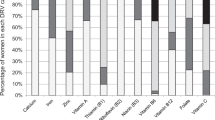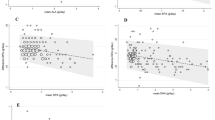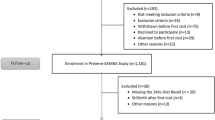Abstract
Objective:
To validate the folate and vitamin B12 intakes estimated by a food-frequency questionnaire (FFQ) designed to be used in a case-control study on the association between maternal dietary intake and the risk of having a child with a congenital heart defect.
Design and subjects:
The FFQ was filled out by 53 women of reproductive age. Immediately thereafter, blood samples were taken to determine serum folate, red blood cell (RBC) folate and serum vitamin B12 concentrations. Subsequently, three dietary 24-h recalls (24HR) were completed during a period of three successive weeks and used as a reference method. The recalls comprised two weekdays and one weekend day. Using the method of triads, validity coefficients were calculated by comparing nutrient intakes derived from the FFQ and 24HR with the corresponding nutritional biomarkers in blood. The validity coefficient is the correlation between the dietary intake reported by the FFQ and the unknown ‘true’ dietary intake.
Results:
The comparison of B-vitamin intakes reported by the FFQ and the mean of the 24HR revealed deattenuated correlation coefficients of 0.98 for folate and 0.66 for vitamin B12. The correlation coefficients between the B-vitamin intakes estimated by the FFQ and concentrations of serum folate, RBC folate and serum vitamin B12 were 0.20, 0.28 and 0.21, respectively. The validity coefficients for serum folate, RBC folate and serum vitamin B12 were 0.94, 0.75 and 1.00, respectively. The estimated folate and vitamin B12 intakes were comparable with the results of the most recent Dutch food consumption survey.
Conclusions:
The adapted FFQ is a reliable tool to estimate the dietary intake of energy, macronutrients, folate and vitamin B12 in women of reproductive age. Therefore, this FFQ is suitable for the investigation of nutrient-disease associations in future.
Sponsorship:
Funding was provided by the Netherlands Heart Foundation (Grant 2002.B027).
This is a preview of subscription content, access via your institution
Access options
Subscribe to this journal
Receive 12 print issues and online access
$259.00 per year
only $21.58 per issue
Buy this article
- Purchase on Springer Link
- Instant access to full article PDF
Prices may be subject to local taxes which are calculated during checkout
Similar content being viewed by others
References
Bacardi-Gascon M, Ley y de Gongora S, Castro-Vazquez BY, Jimenez-Cruz A (2003). Validation of a semiquantitative food frequency questionnaire to assess folate status. Results discriminate a high-risk group of women residing on the Mexico–US border. Arch Med Res 34, 325–330.
Bailey LB (1990). Folate status assessment. J Nutr 120, 1508–1511.
Bates CJ, Thurnham DI (1995). Biochemical markers of nutrient intake. In: Margetts BM, Nelson M (eds). Design Concepts in Nutritional Epidemiology. Oxford University Press: New York, pp 204–235.
Black AE, Goldberg GR, Jebb SA, Livingstone MB, Cole TJ, Prentice AM (1991). Critical evaluation of energy intake data using fundamental principles of energy physiology: 2. Evaluating the results of published surveys. Eur J Clin Nutr 45, 583–599.
Chanarin I (1990). The Megaloblastic Anaemias, 3rd edn. Blackwell Scientific Publications: London.
Cikot RJ, Steegers-Theunissen RP, Thomas CM, de Boo TM, Merkus HM, Steegers EA (2001). Longitudinal vitamin and homocysteine levels in normal pregnancy. Br J Nutr 85, 49–58.
de Jonge R, Griffioen PH, van Zelst B, Brouns RM, Visser W, Lindemans J (2004). Evaluation of a shorter methionine loading test. Clin Chem Lab Med 42, 1027–1031.
Feunekes GI, Van Staveren WA, De Vries JH, Burema J, Hautvast JG (1993). Relative and biomarker-based validity of a food-frequency questionnaire estimating intake of fats and cholesterol. Am J Clin Nutr 58, 489–496.
Goldberg GR, Black AE, Jebb SA, Cole TJ, Murgatroyd PR, Coward WA et al. (1991). Critical evaluation of energy intake data using fundamental principles of energy physiology: 1. Derivation of cut-off limits to identify under-recording. Eur J Clin Nutr 45, 569–581.
Goris AH, Westerterp-Plantenga MS, Westerterp KR (2000). Undereating and underrecording of habitual food intake in obese men: selective underreporting of fat intake. Am J Clin Nutr 71, 130–134.
Green TJ, Allen OB, O'Connor DL (1998). A three-day weighed food record and a semiquantitative food-frequency questionnaire are valid measures for assessing the folate and vitamin B-12 intakes of women aged 16 to 19 years. J Nutr 128, 1665–1671.
Groenen PM, van Rooij IA, Peer PG, Ocke MC, Zielhuis GA, Steegers-Theunissen RP (2004). Low maternal dietary intakes of iron, magnesium, and niacin are associated with spina bifida in the offspring. J Nutr 134, 1516–1522.
Harrison GG, Galal OM, Ibrahim N, Khorshid A, Stormer A, Leslie J et al. (2000). Underreporting of food intake by dietary recall is not universal: a comparison of data from Egyptian and American women. J Nutr 130, 2049–2054.
Health Council of the Netherlands (2001). Dietary reference intakes: energy, proteins, fats, and digestible carbohydrates. Publication No. 2001/19, Health Council of the Netherlands: The Hague.
Health Council of the Netherlands (2003). Dietary reference intakes: vitamin B6, folate and vitamin B12 . Publication No. 2003/04, Health Council of the Netherlands: The Hague.
Hulshof KFAM, Ocke MC, van Rossum CTM, Buurma-Rethans EJM, Brants HAM, Drijvers JJMM et al. (2004). Resultaten van de voedselconsumptiepeiling 2003. RIVM rapport 350030002 (in Dutch). (Results of the national food consumption survey 2003. RIVM report 350030002), National Institute for Public Health and the Environment: Bilthoven, The Netherlands.
Johansson I, Hallmans G, Wikman A, Biessy C, Riboli E, Kaaks R (2002). Validation and calibration of food-frequency questionnaire measurements in the Northern Sweden Health and Disease cohort. Public Health Nutr 5, 487–496.
Kaaks RJ (1997). Biochemical markers as additional measurements in studies of the accuracy of dietary questionnaire measurements: conceptual issues. Am J Clin Nutr 65 (Suppl), 1232S–1239S.
Konings EJ, Roomans HH, Dorant E, Goldbohm RA, Saris WH, van den Brandt PA (2001). Folate intake of the Dutch population according to newly established liquid chromatography data for foods. Am J Clin Nutr 73, 765–776.
Messerer M, Johansson SE, Wolk A (2004). The validity of questionnaire-based micronutrient intake estimates is increased by including dietary supplement use in Swedish men. J Nutr 134, 1800–1805.
Netherlands Nutrition Centre (1993). Zo eet Nederland 1992 (in Dutch). (Dutch National Food Consumption Survey 1992). Netherlands Nutrition Centre: The Hague.
Netherlands Nutrition Centre (1998). Zo eet Nederland 1998 (in Dutch). (Dutch National Food Consumption Survey 1998). Netherlands Nutrition Centre: The Hague.
Netherlands Nutrition Centre (2001). NEVO: Dutch food composition database 2001. Netherlands Nutrition Centre: The Hague.
Ocke MC, Kaaks RJ (1997). Biochemical markers as additional measurements in dietary validity studies: application of the method of triads with examples from the European Prospective Investigation into Cancer and Nutrition. Am J Clin Nutr 65 (Suppl), 1240S–1245S.
Pufulete M, Emery PW, Nelson M, Sanders TA (2002). Validation of a short food frequency questionnaire to assess folate intake. Br J Nutr 87, 383–390.
Rosner B, Willett WC (1988). Interval estimates for correlation coefficients corrected for within-person variation: implications for study design and hypothesis testing. Am J Epidemiol 127, 377–386.
Sauberlich HE (1999). Laboratory Tests for the Assessment of Nutritional Status, 2nd edn. CRC Press: Boca Raton, FL.
Schofield WN (1985). Predicting basal metabolic rate, new standards and review of previous work. Hum Nutr Clin Nutr 39, 5–41.
Sevak L, Mangtani P, McCormack V, Bhakta D, Kassam-Khamis T, dos Santos Silva I (2004). Validation of a food frequency questionnaire to assess macro- and micro-nutrient intake among South Asians in the United Kingdom. Eur J Nutr 43, 160–168.
van Rooij IA, Ocke MC, Straatman H, Zielhuis GA, Merkus HM, Steegers-Theunissen RP (2004). Periconceptional folate intake by supplement and food reduces the risk of nonsyndromic cleft lip with or without cleft palate. Prev Med 39, 689–694.
Willett W (1998). Biochemical indicators of dietary intake. In: Willett W (ed). Nutritional Epidemiology. Oxford University Press: New York, pp. 204–206.
Willett WC, Howe GR, Kushi LH (1997). Adjustment for total energy intake in epidemiologic studies. Am J Clin Nutr 65 (Suppl), 1220S–1228S.
Acknowledgements
The funding was provided by the Netherlands Heart Foundation (Grant 2002.B027). We thank Mrs E Siebelink and Mrs S Meyboom for assistance in the execution of the 24-h recalls and the data extraction of the FFQ, respectively. We gratefully acknowledge the statistical assistance of Mr Jan Burema and thank Mr B van Zelst and Mr R de Nooijer for laboratory assistance.
Author information
Authors and Affiliations
Corresponding author
Additional information
Guarantor: RPM Steegers-Theunissen.
Contributors: ACV collected the data, performed the statistical analysis and wrote the first draft of the manuscript. JHMV was responsible for the adaptation of the FFQ and analysis with the method of triads. MS collected the 24-h recall data and was involved in data-entry and statistical analysis. JL supervised the laboratory measurements. NTCU participated in data analysis. RPMS initiated and supervised all aspects of the study. All authors participated in the interpretation of the results and the final version of the manuscript.
Rights and permissions
About this article
Cite this article
Verkleij-Hagoort, A., de Vries, J., Stegers, M. et al. Validation of the assessment of folate and vitamin B12 intake in women of reproductive age: the method of triads. Eur J Clin Nutr 61, 610–615 (2007). https://doi.org/10.1038/sj.ejcn.1602581
Received:
Revised:
Accepted:
Published:
Issue Date:
DOI: https://doi.org/10.1038/sj.ejcn.1602581
Keywords
This article is cited by
-
Hypertension and diabetes, but not leptin and adiponectin, mediate the relationship between body fat and chronic kidney disease
Endocrine (2024)
-
Pre- and post-diagnostic dairy intake in relation to recurrence and all-cause mortality in people with stage I-III colorectal cancer
European Journal of Nutrition (2023)
-
Timing of physical activity in relation to liver fat content and insulin resistance
Diabetologia (2023)
-
Is a colorectal neoplasm diagnosis a trigger to change dietary and other lifestyle habits for persons with Lynch syndrome? A prospective cohort study
Familial Cancer (2021)
-
Adherence to dietary guidelines in relation to visceral fat and liver fat in middle-aged men and women: the NEO study
International Journal of Obesity (2020)



